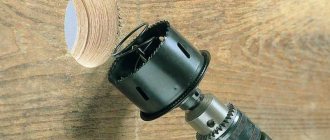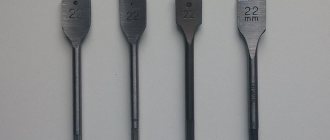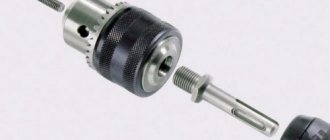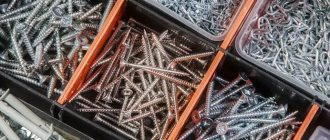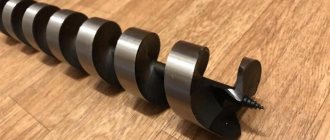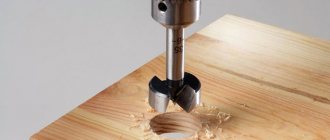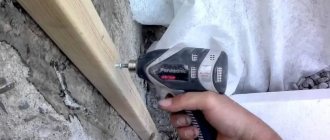The chisel as the main carpentry device for making holes and recesses in wood has largely lost its relevance. At the same time, the problem of crooked cavities and the need for constant sharpening of the tool disappeared. The labor-intensive process is simplified with a device that can easily perform circular drilling. wood core bit
Crowns are large-diameter wood drills with a cutting edge in the form of teeth.
Varieties of wood drills: from thin spirals to large diameter crowns
Wood is a universal material that can be used both in the manufacture of elegant decorative elements and in the construction of buildings and other large-scale objects. Wood is easy to process; for this purpose, the industry produces a large number of tools for various purposes. Among them are the following:
- twist drills. There is such a tool in almost every home. The diameter of the nozzles has a range of 3-52 mm. Drills up to 10 mm are made with a smooth shank; more powerful products are equipped with a hexagonal element, which promotes strong clamping, which is necessary due to the increased load on the cutting segment;
One of the types of ring drills is considered to be a wood crown.
- feather drills. The tool is quite difficult to use. Outwardly it resembles a knife, sharpened from different sides. The functionality of such a nozzle is limited; it is not recommended to make deep holes with it, since chip removal is not provided;
- Forstner drills. The side blades are located around the circumference. The tool produces very clean cuts and is made of durable carbon steel;
- crowns These are large-diameter wood drills with a tooth-shaped cutting edge located on a round end.
The content of this article will be devoted specifically to crowns, their technical characteristics and methods of use.
How to make a drill with your own hands
The easiest way to make a feather metal drill for wood. To do this you will need a regular nail. The nail head must be riveted, sawed and sharpened. It is necessary to take into account that the drill will rotate clockwise.
If you plan to work with chipboard, then it is recommended to give the hat the shape of a sharp spear tip. With this solution, the hole is obtained not by drilling and removing chips, but by simply inserting the drill into the material. And this option is suitable for drilling holes for screws.
To lengthen the drill, you can weld a piece of rod of the required length to the shank. A small extension of about 0.5 cm can be obtained by inserting a piece of chopstick into the chuck with a diameter slightly smaller than the shank.
A device for drilling holes with a diameter of 15 to 45 mm in wooden products can be created from a steel rod with a longitudinal slot and a piece of unnecessary hacksaw blade. The cutting edges of the blade are sharpened at an angle of 45°, inserted into the slot of the rod and connected with a soldering iron.
Note! Before you start working with such a tool, use a regular drill (its diameter should be slightly larger than the diameter of the homemade workpiece) to drill a guide hole.
Then the shank of a homemade drill is clamped in the drill chuck, and the protruding part of the rod is inserted into the guide hole. After this, you can proceed directly to drilling.
A thin drill can easily be replaced by a sewing needle if its end is sharpened from the eye side. The drill is also easy to make from annealed steel wire. The working end of the wire head is heated until hot (the metal should turn light red), and then dipped in sealing wax - this is the manufacturing method.
Wood bit: device and principle of operation
A wood hole saw, also called a hole saw, core drill or end mill, is shaped like a cylinder with one end ending in a shank and the other with a serrated cutting edge. This device serves as an attachment for the torque elements of drills, hammer drills, and screwdrivers intended for manual work. It is possible to use circular cutters for machine tools.
The crown is installed in a special glass and secured with a nut. Each hole saw comes with a drill bit that extends beyond the line of the cutting teeth, allowing you to accurately determine the center of the hole and ensure a perfectly straight cut.
The cutting head is made in the form of a solid cylindrical edge with sharp teeth.
The crown can be either a monolithic structure - a cylinder with a serrated edge, or a collapsible one - cutting rings of different sizes are inserted into a round seat.
If it is necessary to make a perfectly correct and clean hole, bimetallic wood crowns are used. They are made of high-strength steel and cobalt. This connection makes the tool durable in use.
On a note! When choosing a wood crown, you should carefully study its technical characteristics and compare it with the equipment available for the hammer drill (drill, screwdriver). A discrepancy can lead to both damage to the bit and damage to the power tool.
How to drill a hole in wood without a drill
To cut out the elements of the internal ornament, you need to make a hole in the part and thread a saw blade through it. If you don't have a special drill at hand, there are several other methods.
The easiest way to obtain such holes is to use an awl with a diameter of 1 to 3 mm. This awl can be easily made from a thick needle or even from a piece of piano wire, the length of which is approximately 5 cm. The needle or wire is first hammered half the length into a piece of hardwood, and a handle is subsequently made from this wood. The end of the wire remaining outside is sharpened into 3 or 4 edges. A well-made awl in this case acts like a drill, piercing the wood, it is rotated and it cuts and turns out the wood fibers, and does not just push them apart.
DIY drill
Small-sized hand drills, the like of which you can make yourself, are best suited for this operation. To do this, two laces and a handle are tied on top to a rigid axis, which can be a steel or wooden rod, and a sharpened nail on the bottom. in the middle of the rod you need to attach a heavy flywheel, which will act as an inertial battery. in order to put this drill into action, the laces are manually wound onto the rod, and then, after installing the nail in the right place, they press the handle. the rod rotates and the nail is drilled, the pressure on the handle is stopped when the laces are completely untwisted. the flywheel rotates by inertia and screws them onto the rod again, and then stops and you need to press the handle again. Viscous wood species may not yield to such a drill, as the drill will get bogged down and slow down its rotation.
DIY screw drill
For the construction of a screw drill, a rotation mechanism from a children's top is well suited. Instead of a cartridge, a pencil holder from a compass works well. When you lower the engine with the same thread by hand, the screw axis of the drill begins to rotate. With this mechanism of action, the drill head must rotate freely on the axis. If you don’t have a top at hand, you can bend the screw of this action yourself. To do this, you will need a strip of steel, one end of which must be secured in a vice mounted on a machine or on a table, and the other end must be secured in a hand vice. When the hand vise is rotated, the strip is evenly twisted into a screw, onto which a wooden slider with a pre-drilled hole is then mounted. In order to ensure that the engine does not have any difficulties when passing the screw surface of the strip, the strip is heated and, passing through it in this state with the engine, a thread is made on the strip. To make a hat, a small wooden ball with a hole slightly larger in diameter than the diameter of the screw is suitable.
Technological parameters and sizes of wood crowns
The operational capabilities of a crown directly depend on its technological parameters. They are the ones that are evaluated when choosing one type of attachment or another. The main indicators include:
- height. It is equal to the distance from the surface to the lowest point of the sample that the cutter performs in one pass. Usually it is standard and equal to 40 mm;
The bit consists of a cutting head, a shank and a pilot drill with a pointed end.
- diameter. Wood crowns vary depending on the outer diameter of the cutting part. Products from the sets have an indicator of 30-150 mm. The diameter of separately sold nozzles can reach 300 mm;
- number and profile of teeth. The larger the diameter of the crown, the greater the number of teeth the cutting edge is equipped with. They can have the shape of a regular triangle or have a top inclined by 30-40° (the inclination is the same for all teeth);
- additional tool functions. Some devices can perform reverse rotation, that is, change the direction of movement of the crown. This option is most often used by professionals in their work;
- engine power and the ability to adjust the speed. These indicators should be comparable to the type of nozzle. For example, when using a 68 mm wood bit, the permissible speed is 950 rpm. For a 110 mm crown – 500 rpm. The larger the crown, the fewer revolutions are needed to perform the job well.
Note! If it is impossible to reduce the speed of a working power tool, you should use a special stand, which can be purchased at the appropriate stores.
Alternative Methods for Making Square Holes
The production of radius arcs leads to a significant decrease in the quality of the resulting product. That is why the possibility of using other methods for obtaining a square hole is often considered:
- Laser systems are widely used today. They can be used for processing along a given trajectory; when the beam is focused, the metal is heated, due to which the required surface is formed.
- The stamping method has been used for a long period. It involves the use of special equipment that is capable of exerting high pressure on sheet and other workpieces. The disadvantage of this method is the high cost of the equipment, as well as the possibility of obtaining only shallow recesses.
- When using gas welding, it is also possible to form a rectangular shape. However, this technology is characterized by low practicality in application, and the resulting products are of low quality.
https://youtube.com/watch?v=60WbTPNFT-8
There are special sets of punches on sale that can also be used in this case. The kit is represented by a combination of the following elements:
- Bushing for guiding the punch.
- Special holder.
- Ring travel stop.
- Matrix.
Set of punches
In order to place a high load on the working tool, a hydraulic jack is used. This technology is characterized by the fact that the resulting figure has clean and even edges, that is, additional mechanical processing is not required to improve the quality of the surfaces.
Scope of application and operating features of wood crowns 50, 60, 68 mm
One of the quite frequently used ones is a crown with a diameter of 50 mm. It can be sold either separately or as a set. The nozzle is made of carbon steel, but you can also find products made of hardened metal. Number of cutting teeth – 30-34 pcs. Any type of this natural material, including wood boards with a laminated coating, can be treated with a 50 mm wood crown.
For hard trees (oak, hornbeam, beech, etc.), it is better to use circular saws made from carbon steel or bimetal. Such attachments will cope well with dense structures, performing a neat and correct cut, and will also last much longer.
The technical and operational characteristics of 60 mm wood crowns largely coincide with the properties of models with a diameter of 50 mm described above. This option is in demand and is used for various household needs, as well as in the manufacture of furniture. You can purchase bits with a diameter of 50 and 60 mm in any store that sells power tools, as well as directly from the manufacturer. The second option will not require overpayment for commercial services. The simplest metal models will cost 100-130 rubles.
A crown with a diameter of 68 mm is a “classic of the genre.” This is the most common and frequently used model, since it is used to make sockets for socket boxes in wooden walls and wall sandwich panels, which include wood boards. The attachments are made of alloy or carbon steel, which ensures an ideal cut of wood of any quality.
Wood crown 100 mm, 110 mm, 120 mm: types, prices, material of manufacture
Crowns with a diameter of 100, 110, 120 mm are more often used for the manufacture of decorative products. During repairs, they can be used to install distribution boxes for various communications. This diameter requires the corresponding power of the power tool to which the nozzle will be attached, and it should not be less than 800 W.
When using nozzles with a diameter of 120 mm, you need to select a tool that is appropriate in terms of power.
Wood crowns 110-120 mm belong to the medium-sized type, so all manufacturers have them, which allows you to choose the appropriate option both in terms of technical and price indicators.
Products can be sold as separate attachments or as removable rings as part of sets. High-strength steel is used as the manufacturing material. Some manufacturers (Bosh, Matrix, Biber) make bimetallic hole saws of this diameter, which are highly durable and have a good service life.
Before using bits of this size, there is no need to pre-cut the hole, and after drilling there is no need to treat the internal surface.
The price range for these attachments is significant. For example, a 120 mm Matrix wood crown costs 300 rubles, an analogue costs 80 rubles.
Crowns can be sold as individual attachments or as removable rings as part of sets.
Technical and operational characteristics of wood crowns 127 mm, 150 mm, 160 mm
Wood crowns 127, 150, 160 mm are classified as large diameter bits. Almost all of them are bimetallic models, since drilling large holes requires a durable cutting tool. The 127mm diameter bit may be sold separately, but is often the largest bit in a bit set.
The price of a separate bimetallic version reaches 1000 rubles. A set of metal crowns can be purchased for almost the same money - 900-1000 rubles.
Wood crowns 150 mm are successfully used when performing repair work. With their help, holes are made for ventilation, lamps, and septic tanks are installed. For such a crown, you need a power tool with the ability to adjust the speed. The first cuts are made at a frequency of 950-1300 rpm, for subsequent cuts the rotation speed must be reduced to 500-600 rpm.
DeWalt and Bosh crowns are especially popular. Products from these manufacturers have increased strength, in which the cutting part is not damaged even when it comes into contact with metal elements.
Crowns with a diameter of 127 mm are most often sold in sets.
Wood crowns 160 mm can be used to perform decorative work on wood, as well as during construction or repair work in houses built from timber. This bimetallic nozzle successfully penetrates even the hardest layers of wood, leaving behind an ideal inner surface. Technical and operational characteristics practically coincide with the properties of 150 mm crowns, but the price is slightly higher (10-12%).
On a note! When making holes with large-diameter crowns in particle boards, do not put pressure on the cutting edge in case of difficult passage - small chips may form on the upper edges of the hole.
Carbide
The cutting part of carbide bits is brazed from an alloy called “win” ( 90 % tungsten and 10 % cobalt). The main advantage is low cost, and the main disadvantage is the short service life. Such cutters are very vulnerable and must be treated with care.
This is the right choice if you need to make 1 - 10 holes for socket boxes in concrete or brick walls. The products are not suitable for large volumes.
When it comes into contact with reinforcement, strong teeth are broken out of the “blank”, especially in products made in Asia. Therefore, you should avoid reinforced areas .
Wood crowns 210 mm: selection of power tools, prices
A crown with a diameter of 210 mm is a reliable attachment. More often it is purchased by professionals to perform construction and repair work. Moreover, it can make holes not only in wood, but also in plaster, sheet steel, and plastic. The product is bimetallic, durable.
Not every power tool is compatible with such an attachment. This could be a hammer drill or a powerful drill. No screwdriver will ensure full operation of such a hole saw. The power of the device should not be lower than 1300 W. The function of changing the speed is required. A nozzle of this size is often used for stationary devices, since manually working with a hammer drill with such a cutter is quite problematic.
The price of crowns with a diameter of 210 mm varies significantly among different manufacturers.
For uninterrupted and high-quality operation of crowns on wood of large diameter (210-250 mm), the speed should be set correctly:
- the optimal indicator for drilling soft wood is 350-400 rpm;
- when making holes in hard wood – 500-600 rpm.
These attachments are often sold as a separate option rather than as a set. The price of crowns with a diameter of 210 mm varies significantly among different manufacturers. For example, a similar hole saw from the American company DeWalt will cost 630 rubles. A nozzle with absolutely identical technical and operational characteristics “Bison” costs 1030 rubles.
How to drill a long hole in wood. Deep holes with a drill
Drilling deep holes has always been a problem. This little tool is designed to help hand and electric drills drill deep holes through the center of a piece of wood, which you know is very hard. And the deeper the hole, the more difficult it is to drill. The problem often arises in the hole itself and drilling the hole axially into the end of the block. In this case, this simple device will help you confidently hold the drill in one direction and move away from the wandering center. Such drills tend to follow the path of least resistance. To solve this problem, use a special device, which is shown in the photo above. The device will keep the drill from changing direction in the wood. These drill bits are good enough for drilling holes in softwood, but are not as good in hardwood and require frequent sharpening of the bit. Drill bits are available for sale in stores and come in a variety of diameters and lengths, allowing you to drill holes up to 400mm deep.
How to drill deep holes correctly.
Minor change to the drill. When modifying an auger drill, start by stripping the guide screw. Then blunt the edges as shown in the photo below. This modification will provide a slight “bite” and without being too aggressive helps to drill deep holes in a straight direction.
Alignment. Straight metal rod, aligns V-block with inspection hole.
Start with the pilot hole. Another problem is drilling deep holes, setting a straight hole as a guide. A drill press is a seemingly logical tool that can be used to drill straight holes, but it has a limited drilling depth. However, the drill press still plays a big role in this operation and serves to drill the pilot hole. I start drilling the hole with a drill of a smaller diameter and gradually increase the hole to the diameter that I plan to use.
When the drill chuck rests on the V-block, remove it and drill a hole the full length of the drill bit or the depth of the hole.
Keep the drill straight. Once the pilot hole is ready, install a drill of the required diameter in the drill, and secure the workpiece on the workbench with clamps. Remember that even if you have a good and tight hole, moving the drill bit from the center while drilling will not save it. To help guide the drill into the hole along the axis line, a V-block is made. To adjust the alignment, take a long metal rod and insert it into the pilot hole as shown in the photo above, align the V-block in line with the rod in the block and secure with a clamp. I start drilling holes with a drill at low speeds. Don’t be lazy and often clean the drill from sawdust clogging the auger, this gives easy rotation to the drill and helps to guide the drill correctly. Once the drill chuck rests against the V-block, remove it and continue drilling the hole. Performing these simple and not complicated techniques allows you to get excellent results.
Bosch wood crowns: types of attachments, applications, prices
Bosch tools have long been established in the domestic market and almost always occupy a leading position. Bosch is a brand that does not enjoy past merits, but confirms its status with constant improvement of technology. Products from this manufacturer have the following characteristics:
- good quality material. Small-diameter bits are mainly made of high-speed steel, wood bits 110 mm or more are bimetallic (high-speed steel alloyed with cobalt), resistant to mechanical loads and ensuring an even cut when making holes;
Bosch bits are durable, do not overheat, and do not deform during the sawing process.
- variety of species. The Bosch company offers saw bits with sizes from 14 to 152 mm, sets with a set of 5-13 attachments, saw blades for 5-8 elements. The latter are a convenient option for making rough holes in hard and soft materials;
- optimal configuration. All drill bits from this manufacturer come with Power Change adapters: for drills it’s a hexagon, for hammer drills it’s an SDS Plus mount.
Bosch hole saws can be used to make holes in sheet metal, wood, laminated wood boards, plasterboard, plastic, laminate, and multi-layer materials. The price of crowns ranges from 400 rubles for a 14 mm nozzle, 1000 rubles for a 120 mm wood crown to 3500 rubles for a 300 mm bimetallic hole saw.
Note! Having chosen a Bosch hole saw, you should simultaneously purchase cutting oil and a spare centering drill (if you plan to use the hole saw intensively and for a long time) from this manufacturer. These necessary consumables will ensure high-quality operation of the tool for a long time.
Twist drills
Spiral modifications are the most common on the market; their appearance is familiar to almost every craftsman. Spiral (or screw - this is their second name) drills consist of a working part, a cutter neck and a shank for fastening in the drill. In the working part there are two screw grooves. This is a cutting and chip removal element. If the equipment has the appropriate capabilities, it is through these grooves that lubricant is supplied to the drilling zone.
Long beam drills (Levis) have a spiral shape. Their distinctive features are their elongated dimensions and pointed end. They are used in carpentry when fastening beams together.
Spiral products in general are applicable not only to working with wood, but also for harder materials. The diameter of the spiral nozzles can be from 8 to 60 centimeters, and the length - from 0.3 to 5.2 centimeters. In addition, they can be of two types:
- with conical tip;
- with trimmer.
In terms of performance, both types are approximately the same.
In general, the procedure for working with twist drills will largely depend on the diameter. If, suppose, the diameter of the spiral nozzle is no more than 14 mm, then the drilling speed should be about 1800 rpm for soft wood and 750 for hard wood. If the diameter is from 14 to 25 mm, then for soft rocks you need 1500 revolutions, and for hard rocks - 500 revolutions per minute. That is, the larger the diameter, the less revolutions are required.
A worthy product of domestic production: a set of wood crowns “Bison”
"Zubr" is a domestic manufacturer of hand-held power tools, including ring drills for working on wood, wood materials, plaster, and plastic. Wood crown sets are especially popular. “Zubr” is a company that not only produces high-quality goods, but also provides them with worthy support, taking care of customers. Having picked up a cardboard package, you can easily find on it all the necessary information about the number of items, the quality of the material, the method of application and compliance with the power tool.
produces wood crowns with centering drills made of high-tech tool steel.
The kit units are conveniently placed in a compact plastic case, on the inside of the upper part of which there is a detailed assembly diagram of the nozzle. The standard kit includes the following items: 5 hole saws, a centering drill, a hex shank, a trim strip and a key. The kits can have drills of different sizes: from 64 to 102 mm, from 33 to 83 mm, etc.
The main material for making wood crowns “Bison” is high-quality carbon steel. The medium tungsten carbide chip, which forms the basis of the spraying, allows you to make even cuts and significantly extends the service life of the cutting edge.
A set of ring attachments costs 500-700 rubles. Kits with a large number of circular saws (10-12) have a price of 1000-1500 rubles.
At what speed should I use my drills?
Use diamond drill bits at low speed, especially when making the initial hole. This will prevent material breakage and extend the life of the drill.
It is recommended to use the lowest drill setting, but if you are drilling a hole all the way through the material and really increasing the speed, make sure you slow down as you approach the exit hole to prevent cracking.
Keeping the speed low when drilling will help prevent material damage and extend the life of your drill bits.
Affordable and functional option: Anchor wood crowns
Enkor crowns are manufactured in China and sold by a Russian company located in the city of Voronezh. Compared to Bosch products, these attachments are a more simplified option, but at the same time they do not lose their performance. With their help, you can make blind and through holes in wood, wood boards, plasterboard and plastic.
Anchor bits are installed on a regular household drill and are suitable for working with wood, plastic, plywood, chipboard, and MDF.
For the manufacture of nozzles, mainly high-strength steel is used, which has an external coating that protects against corrosion. For the sake of objectivity, it should be noted that during work the protective layer is significantly damaged by mechanical influences, so it is worth providing the necessary conditions for the safety of the tool.
Anchor bits up to 65 mm have a shank with a diameter of 19 mm, bits for wood 68 mm and more are equipped with a 32 mm fastener.
It is worth noting that the products of this manufacturer are distinguished by a variety of sizes, which allows you to select the desired diameter and make a hole without additional drilling and unnecessary voids. For example, in the range from 80 to 90 mm, you can choose a nozzle of 80, 82, 85, 88, 90 mm.
Anchor hole saws are characterized by affordable prices. You can actually buy a 22 mm crown for just 50 rubles. A very popular version of the nozzle with a diameter of 70 mm costs 100 rubles. The price of a 127 mm crown is 175 rubles.
Bimetallic products do not dull for a long time, even in contact with nails and fittings.
Hole saws from this manufacturer do not have a long service life. With proper use and storage, they will serve for a long time, fulfilling their purpose with dignity.
Simplicity of the device and wide possibilities: ballerina on wood
If it is necessary to make a large-diameter hole in the material, a drill can be used, which in everyday life has received a very euphonious name - ballerina (due to the external similarity of the separated cutting elements of the device with the image of a dancer). Such a device consists of a centering drill and cutters, which move apart along the guide in different directions at the same distance, thereby outlining the dimensions of the diameter of the future hole. Most ballerinas have two incisors, but there are also models with three.
The operating principle of this type of drill bit:
- the central drill makes a hole in the material;
- the incisors mark a circle line, which determines the size of the future recess;
- The device is set in motion manually (using a rotary tool) or using a rotary power tool.
Most ballerinas have two or three incisors.
With a ballerina, you can make holes in wood, wood materials, drywall, ceramic tiles, and plastic. This attachment is inexpensive and quite suitable for non-professionals.
On a note! When using a ballerina as an attachment for a manual mechanism, efforts should be made when carrying out the centering and first rotational movements of the incisors, outlining the contour of the future recess. Uncertain movements can cause chips on the top edge of the material.
Equipment and accessories for drilling
A tool for drilling holes has been developed for each stage. At the preparatory stage, the following tools are used to accurately mark the location of the future hole. To do this, use: a core, a special template or a jig. The core is a well-sharpened rod made of durable tool steel. With its help, a depression is made on the surface of the workpiece, at the point where it is planned to drill. Once in this recess, the drill does not slip on the surface and accurate drilling is performed.
To increase productivity, mass production plants make special templates. They allow you to mark the locations of future holes in workpieces of the same type. Special templates are used for drilling on cylindrical surfaces. They are made from a steel strip bent at a right angle. A small hole is drilled on one of the surfaces, which will later allow a core to make a mark on the cylindrical surface.
To obtain increased marking accuracy, maintain the vertical position of the drill and maintain the specified distance, a tool called a jig is used between the holes. In addition, it is used when drilling thin-walled products for which strong mechanical impact is not possible (for example, hitting a core with a hammer).
In addition to these products, tools and devices are used that allow drilling with a drill with its rigid fixation. For this purpose I use:
- guide clamp;
- holding stand;
- jig to direct the movement of the drill.
The first two devices are made for a specific electric drill design. The jig allows you to accurately guide the drill to the location of the future hole. It is successfully used for sizes not exceeding 20 millimeters. Therefore, when making large-diameter holes using a jig, preliminary drilling is performed.
All these problems are easily solved by using drilling or lathes. Drilling machines are divided into three categories:
- universal;
- specialized;
- special.
They are classified according to the following criteria:
- table design;
- level of automation;
- number of available spindles;
- degree of accuracy;
- availability of additional features.
The first category of machines allows you to solve almost the entire range of problems in the production of holes. A serious limitation is the permissible distance over which the chuck with a fixed drill can move. This circumstance does not allow drilling to great depths. In this case, specialized machines are used. To increase labor productivity and increase the number of similar parts produced, special units are designed. They are able to perform a list of necessary operations with high accuracy and speed.
By design, such machines are available with one or more spindles. The design of the table is varied: regular, floating, lifting and others. The level of automation is determined by the way drilling operations are performed. The simplest machines are manual and mechanical. Automatic and numerically controlled machines are more advanced.
In addition to drilling machines, various lathes are used to solve these problems.
On lathes you can perform the entire list of operations related to making holes: drilling itself, drilling followed by reaming or countersinking.
Wood core drill: conditions for proper use
For a tool to function properly, it must be used correctly. This means compliance with the standards and requirements of technical specifications, use in accordance with the intended purpose and compliance with the rules during work:
- a drill with a crown attachment cannot operate continuously for a long time, as it heats up significantly. It is necessary to either equip the tool with an additional cooling system, or take a 15-minute break after every 30-40 minutes of work;
You should choose drills for core bits with high power and a comfortable handle.
- Manufacturers do not produce special crowns for drywall; wood cutters are used for drilling this material. The power of a power tool with torque may be much lower than the optimal value for drilling, for example, beech;
- When working with bits, you should consider the way the shank is connected to the cylinder. If flat soldering is used, it is necessary to avoid lateral loads on the device and be sure to take breaks in work to prevent overheating and the appearance of defects at the joint. In the case when the shank is inserted into the seating part of the bit and soldered, an additional support appears - a shoulder, as a result of which the strength of the connection becomes significantly higher;
- You need to pay attention to the price of wood crowns. You cannot intensively use an attachment purchased for 50-70 rubles and expect a long period of its full operation. For this type of tool, price and resource are directly dependent.
With proper use, the tool will last much longer.
Any tool requires skillful use. When working with crown attachments, it is not so much experience that is important as awareness regarding the technical capabilities of the device and the intended application. The market offers hole saws for both amateur craftsmen and professionals. It's important to make smart choices.
